The Question: How Much is Enough?
In pondering the macro picture over the weekend, it occurred to me that the current environment can be summed up with one simple question: How much is enough? As in, how much do stock prices need to correct from their January blow-off highs in order to create a fairly valued market where longer-term, fundamental oriented investors return to the game in a meaningful way? Or, put another way, how much time needs to go by for rising earnings to create values in the market again? A month? A quarter? A year? How much is enough?
The key problem in trying to come up with an answer is there are host of additional "how much?" questions that need to be answered first. Sure, we can do some math and project what forward P/E's might look like in a few months (and according to "the man who moves markets" - AKA JPMorgan's Marko Kolonavic - valuations are looking better and better). However, there is an awful lot of uncertainty in the markets right now. And until we get some clarity on some of these issues, the question are likely to remain unanswered and the sloppy action is likely to continue.
For example, one of the key questions right now is how much is global growth slowing? Or is it actually slowing at all? Since a fair amount of the recent bull run was based on the idea of synchronized global growth, a slowdown in growth means adjustments need to be made.
Next up is the question of how much inflation is percolating? Everybody on the planet knows that there are "some" inflationary pressures thanks to commodity prices, tariffs, the tightening labor market, etc. But how hot will inflation become in the current environment?
The next question of how high rates will rise goes hand in hand with the inflation issue. While most folks are aware of the inflationary issues and the fact that Jay Powell & Co. are raising rates, the not-so small matter of treasury supply is also a major factor here. Lest we forget, it is estimated that the U.S. Treasury will double the amount of bonds it needs to issue over the next 18 months. So, when you couple this with the Fed unwinding its balance sheet, there can be little argument that there is likely to be upward pressure on rates. But, how much pressure?
Then there are the political and geopolitical risks. How much risk is there relating to what is politely being called a "constitutional crisis" (aka, impeachment proceedings)? Trust me, I'm not taking sides on whether or not this should happen, but I'd be a fool to ignore the possibility of such given everything that is going on in D.C.
On the geopolitical front, the question remains the same, how much risk is there? Are the issues with Korea, Iran and maybe even Russia, real enough to have an impact on markets? If so, please forgive me for asking the same question repeatedly, but how much risk?
And finally, there is the question of how much impact, if any, will there be from the trade fight with China? A lot? A little? None?
So, there you have it. Yes, the economy is growing. But we knew that. The earnings parade has been stellar. But, we knew that was going to be the case too. And companies are investing again in people, plants, and equipment. But, again, with all the hullabaloo surrounding the passage of the tax stimulus bill, none of this is really a surprise.
In sum, I believe the real key to this market is, yep; you guessed it, how much is enough? And if you have any ideas on the answer, please let me know. But in the meantime, I'm going to try and listen to Ms. Market's "message" as closely as I can in order to try and get some clues.
Thought For The Day:
You cannot escape the responsibility of tomorrow by evading it today. - Abraham Lincoln
Wishing you green screens and all the best for a great day,

David D. Moenning
Founder, Chief Investment Officer
Heritage Capital Research
HCR Focuses on a Risk-Managed Approach to Investing
Must Read: What Risk Management Can and Cannot Do
HCR's Financial Advisor Services
HCR's Individual Investor Services
Questions, comments, or ideas? Contact Us
At the time of publication, Mr. Moenning held long positions in the following securities mentioned: None - Note that positions may change at any time.
The State of the Big-Picture Market Models
It's a new week, so let's start things off with a review of the state of my favorite big-picture market models, which are designed to tell us which team is in control of the prevailing major trend.
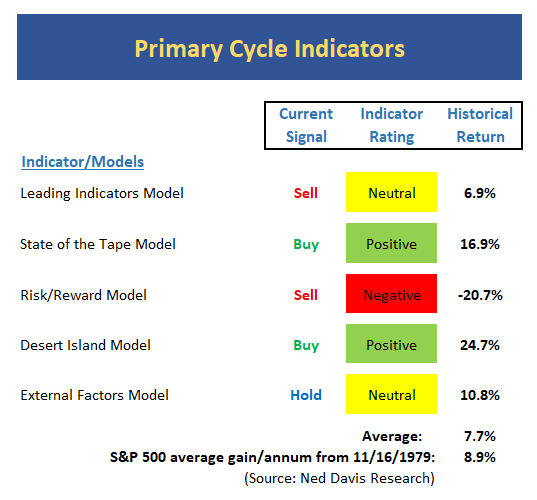
View My Favorite Market Models Online
Executive Summary:
- The long-term Leading Indicators model remains on its recent sell signal, but the model reading itself is currently at the low end of the neutral zone.
- Our "State of the tape" model reading remains positive and hasn't budged. The positive reading is largely a result of the intermediate-term mean-reversion components that are built into the model.
- On the other side of the coin, the Risk/Reward model remains negative and on a sell signal. The divergence between the State of the Tape and the Risk/Reward Model is an excellent indication of how conflicted the current market environment is.
- At the 80-level, the reading of my "desert island" model remains positive. And as I've been saying, this tells me to continue give the bulls the benefit of any doubt. To be sure, this hasn't been easy lately. But so far at least, it appears be the correct call.
- The External Factors model remains in the neutral zone. This tells me that this is NOT a low-risk environment.
- My "bottom line" take is that the market remains conflicted and entrenched in a corrective/consolidation phase. But, the historical returns of the "primary cycles" models tell me to continue to give the bulls some room here.
The State of the Trend
Digging into the details, I like to start my weekly review with a look at the "state of the trend." These indicators are designed to give us a feel for the overall health of the current short- and intermediate-term trend models.
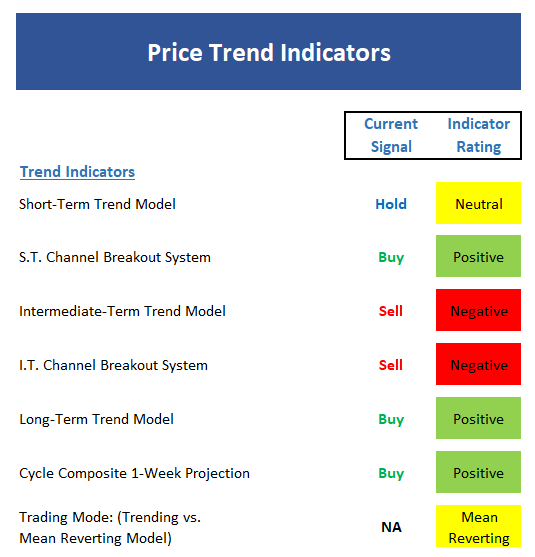
View Trend Indicator Board Online
Executive Summary:
- An up-and-down week left the trend model of the S&P in the neutral zone.
- The short-term Channel Breakout System remains on its 4/26 buy signal. A break below 2594 would trigger a sell.
- The intermediate-term Trend Model remains negative. However, a sustained weekly close above 2670(ish) would turn the model to positive.
- The intermediate-term Channel Breakout System remains on a sell signal and would require a move above 2717 to change to green.
- The bulls should be encouraged by the fact that the long-term Trend Model remains positive.
- The Cycle Composite points to a choppy but slightly higher market for the next week.
- From an intermediate-term perspective, the market remains in a mean-reverting mode.
The State of Internal Momentum
Next up are the momentum indicators, which are designed to tell us whether there is any "oomph" behind the current trend.
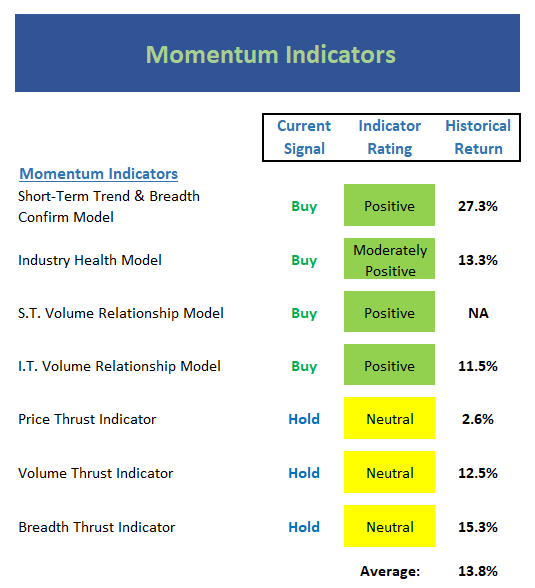
View Momentum Indicator Board Online
Executive Summary:
- The short-term Trend and Breadth Confirm Model has flipped around a fair amount lately but starts the week in the positive zone.
- The Industry Health Model upticked to moderately positive this week due to the fact that the trend of the indicator is now rising. However, the model is a long way from an outright positive reading.
- The short-term Volume Relationship managed to sneak back up into positive territory, but only by the thinnest of margins.
- I continue to believe it is positive that the intermediate-term Volume Relationship model has avoided the negative zone. But keep in mind this is a longer-term indicator.
- The intermediate-term Price Thrust Indicator, which is an oscillator, slipped back into the neutral zone last week.
- The Volume Thrust Indicator reversed from negative to neutral last week - but again, only by a slim margin.
- The Breadth Thrust Indicator also slipped back last week and is now neutral.
- While the action has been sloppy, the momentum board is actually in pretty good shape at the moment.
The State of the "Trade"
We also focus each week on the "early warning" board, which is designed to indicate when traders might start to "go the other way" -- for a trade.
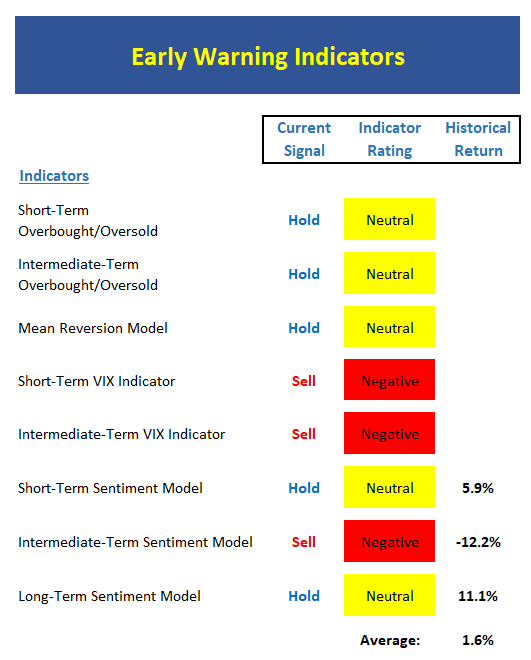
View Early Warning Indicator Board Online
Executive Summary:
- From a near-term perspective, stocks are still in neverland - neither overbought nor oversold.
- From an intermediate-term view, our model suggests stocks are technically neutral. But in reality, the market is closer to being oversold here.
- The Mean Reversion Model closed out a profitable trade on Friday and is now neutral.
- The short-term VIX signal remains on the recent sell signal and is currently set up to issue a repeat sell signal.
- Our longer-term VIX Indicator also remains on a sell signal.
- From a short-term perspective, market sentiment is currently neutral.
- The intermediate-term Sentiment Model remains negative to start the week.
- The long-term Sentiment Model remains at the low end of neutral.
- The early warning board doesn't give either team a clear edge at this point.
The State of the Macro Picture
Now let's move on to the market's "external factors" - the indicators designed to tell us the state of the big-picture market drivers including monetary conditions, the economy, inflation, and valuations.
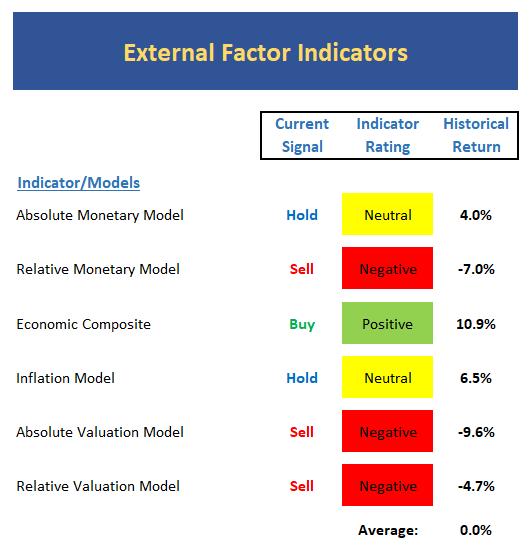
View External Factors Indicator Board Online
Executive Summary:
- The Absolute Monetary model remains at the very low end of neutral. This seems to sum up the monetary situation nicely - It isn't good by any stretch of the imagination, but we don't seem to have enough negativity to signal the start of the much-anticipated secular bear.
- The recent rise in rates has caused the Relative Monetary Model to fall into the red zone.
- Nothing new to report on the economic front. The Economic Models tell us that the economic backdrop continues to be constructive for stocks from an intermediate-term perspective.
- The inflation model remains neutral. However, it is clear that there are inflationary pressures in the pipeline.
- The Absolute Valuation model is clearly negative but continues to improve due to the fact that "P" is going nowhere while "E" continues to improve. I would expect to see more improvement from this model next month.
- Our Relative Valuation Model remains negative as higher rates are now a modest headwind for stocks.
- The bottom line is the External Factors board can be considered neutral at best here.
Sample Tactical Allocation Model
Below is an EXAMPLE (and ONLY an EXAMPLE) of how one might incorporate the indicator boards. The approach shown below is designed to provide the current equity allocation for a balanced tactical asset allocation model with a base target of 60/40 stocks/bonds.
The overall intent of the model is to keep equity exposure in line with current conditions. Since the model is updated monthly, we take a longer-term approach and allocate 40% of the exposure to Environmental factors, 40% to Trend and Momentum factors, and 20% to Sentiment.
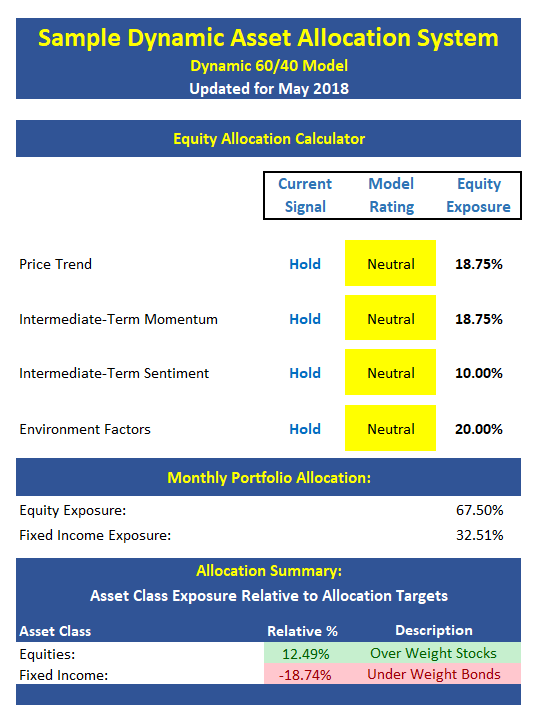
The model above is for illustrative and informational purposes only and does not in any way represent any investment recommendation. The model is merely a sample of how indicators can be grouped to create a guide to market exposure based on the inputs from multiple indicators/models.
Beginning February 2018, the model will be updated monthly.
Indicators Explained
Short-Term Trend-and-Breadth Signal Explained: History shows the most reliable market moves tend to occur when the breadth indices are in gear with the major market averages. When the breadth measures diverge, investors should take note that a trend reversal may be at hand. This indicator incorporates NDR's All-Cap Dollar Weighted Equity Series and A/D Line. From 1998, when the A/D line is above its 5-day smoothing and the All-Cap Equal Weighted Equity Series is above its 25-day smoothing, the equity index has gained at a rate of +32.5% per year. When one of the indicators is above its smoothing, the equity index has gained at a rate of +13.3% per year. And when both are below, the equity index has lost +23.6% per year.
Channel Breakout System Explained: The short-term and intermediate-term Channel Breakout Systems are modified versions of the Donchian Channel indicator. According to Wikipedia, "The Donchian channel is an indicator used in market trading developed by Richard Donchian. It is formed by taking the highest high and the lowest low of the last n periods. The area between the high and the low is the channel for the period chosen."
Intermediate-Term Trend-and-Breadth Signal Explained: This indicator incorporates NDR's All-Cap Dollar Weighted Equity Series and A/D Line. From 1998, when the A/D line is above its 45-day smoothing and the All-Cap Equal Weighted Equity Series is above its 45-day smoothing, the equity index has gained at a rate of +17.6% per year. When one of the indicators is above its smoothing, the equity index has gained at a rate of +6.5% per year. And when both are below, the equity index has lost -1.3% per year.
Industry Health Model Explained: Designed to provide a reading on the technical health of the overall market, Big Mo Tape takes the technical temperature of more than 100 industry sectors each week. Looking back to early 1980, when the model is rated as "positive," the S&P has averaged returns in excess of 23% per year. When the model carries a "neutral" reading, the S&P has returned over 11% per year. But when the model is rated "negative," stocks fall by more than -13% a year on average.
Cycle Composite Projections: The cycle composite combines the 1-year Seasonal, 4-year Presidential, and 10-year Decennial cycles. The indicator reading shown uses the cycle projection for the upcoming week.
Trading Mode Indicator: This indicator attempts to identify whether the current trading environment is "trending" or "mean reverting." The indicator takes the composite reading of the Efficiency Ratio, the Average Correlation Coefficient, and Trend Strength models.
Volume Relationship Models: These models review the relationship between "supply" and "demand" volume over the short- and intermediate-term time frames.
Price Thrust Model Explained: This indicator measures the 3-day rate of change of the Value Line Composite relative to the standard deviation of the 30-day average. When the Value Line's 3-day rate of change have moved above 0.5 standard deviation of the 30-day average ROC, a "thrust" occurs and since 2000, the Value Line Composite has gained ground at a rate of +20.6% per year. When the indicator is below 0.5 standard deviation of the 30-day, the Value Line has lost ground at a rate of -10.0% per year. And when neutral, the Value Line has gained at a rate of +5.9% per year.
Volume Thrust Model Explained: This indicator uses NASDAQ volume data to indicate bullish and bearish conditions for the NASDAQ Composite Index. The indicator plots the ratio of the 10-day total of NASDAQ daily advancing volume (i.e., the total volume traded in stocks which rose in price each day) to the 10-day total of daily declining volume (volume traded in stocks which fell each day). This ratio indicates when advancing stocks are attracting the majority of the volume (readings above 1.0) and when declining stocks are seeing the heaviest trading (readings below 1.0). This indicator thus supports the case that a rising market supported by heavier volume in the advancing issues tends to be the most bullish condition, while a declining market with downside volume dominating confirms bearish conditions. When in a positive mode, the NASDAQ Composite has gained at a rate of +38.3% per year, When neutral, the NASDAQ has gained at a rate of +13.3% per year. And when negative, the NASDAQ has lost at a rate of -8.5% per year.
Breadth Thrust Model Explained: This indicator uses the number of NASDAQ-listed stocks advancing and declining to indicate bullish or bearish breadth conditions for the NASDAQ Composite. The indicator plots the ratio of the 10-day total of the number of stocks rising on the NASDAQ each day to the 10-day total of the number of stocks declining each day. Using 10-day totals smooths the random daily fluctuations and gives indications on an intermediate-term basis. As expected, the NASDAQ Composite performs much better when the 10-day A/D ratio is high (strong breadth) and worse when the indicator is in its lower mode (weak breadth). The most bullish conditions for the NASDAQ when the 10-day A/D indicator is not only high, but has recently posted an extreme high reading and thus indicated a thrust of upside momentum. Bearish conditions are confirmed when the indicator is low and has recently signaled a downside breadth thrust. In positive mode, the NASDAQ has gained at a rate of +22.1% per year since 1981. In a neutral mode, the NASDAQ has gained at a rate of +14.5% per year. And when in a negative mode, the NASDAQ has lost at a rate of -6.4% per year.
Short-Term Overbought/sold Indicator: This indicator is the current reading of the 14,1,3 stochastic oscillator. When the oscillator is above 80 and the %K is above the %D, the indicator gives an overbought reading. Conversely, when the oscillator is below 20 and %K is below its %D, the indicator is oversold.
Intermediate-Term Overbought/sold Indicator: This indicator is a 40-day RSI reading. When above 57.5, the indicator is considered overbought and when below 45 it is oversold.
Mean Reversion Model: This is a diffusion model consisting of five indicators that can produce buy and sell signals based on overbought/sold conditions.
VIX Indicator: This indicator looks at the current reading of the VIX relative to standard deviation bands. When the indicator reaches an extreme reading in either direction, it is an indication that a market trend could reverse in the near-term.
Short-Term Sentiment Indicator: This is a model-of-models composed of 18 independent sentiment indicators designed to indicate when market sentiment has reached an extreme from a short-term perspective. Historical analysis indicates that the stock market's best gains come after an environment has become extremely negative from a sentiment standpoint. Conversely, when sentiment becomes extremely positive, market returns have been subpar.
Intermediate-Term Sentiment Indicator: This is a model-of-models composed of 7 independent sentiment indicators designed to indicate when market sentiment has reached an extreme from an intermediate-term perspective. Historical analysis indicates that the stock market's best gains come after an environment has become extremely negative from a sentiment standpoint. Conversely, when sentiment becomes extremely positive, market returns have been subpar.
Long-Term Sentiment Indicator: This is a model-of-models composed of 6 independent sentiment indicators designed to indicate when market sentiment has reached an extreme from a long-term perspective. Historical analysis indicates that the stock market's best gains come after an environment has become extremely negative from a sentiment standpoint. Conversely, when sentiment becomes extremely positive, market returns have been subpar.
Absolute Monetary Model Explained: The popular cliché, "Don't fight the Fed" is really a testament to the profound impact that interest rates and Fed policy have on the market. It is a proven fact that monetary conditions are one of the most powerful influences on the direction of stock prices. The Absolute Monetary Model looks at the current level of interest rates relative to historical levels and Fed policy.
Relative Monetary Model Explained: The "relative" monetary model looks at monetary indicators relative to recent levels as well as rates of change and Fed Policy.
Economic Model Explained: During the middle of bull and bear markets, understanding the overall health of the economy and how it impacts the stock market is one of the few truly logical aspects of the stock market. When our Economic model sports a "positive" reading, history (beginning in 1965) shows that stocks enjoy returns in excess of 21% per year. Yet, when the model's reading falls into the "negative" zone, the S&P has lost nearly -25% per year. However, it is vital to understand that there are times when good economic news is actually bad for stocks and vice versa. Thus, the Economic model can help investors stay in tune with where we are in the overall economic cycle.
Inflation Model Explained: They say that "the tape tells all." However, one of the best "big picture" indicators of what the market is expected to do next is inflation. Simply put, since 1962, when the model indicates that inflationary pressures are strong, stocks have lost ground. Yet, when inflationary pressures are low, the S&P 500 has gained ground at a rate in excess of 13%. The bottom line is inflation is one of the primary drivers of stock market returns.
Valuation Model Explained: If you want to get analysts really riled up, you need only to begin a discussion of market valuation. While the question of whether stocks are overvalued or undervalued appears to be a simple one, the subject is extremely complex. To simplify the subject dramatically, investors must first determine if they should focus on relative valuation (which include the current level of interest rates) or absolute valuation measures (the more traditional readings of Price/Earnings, Price/Dividend, and Price/Book Value). We believe that it is important to recognize that environments change. And as such, the market's focus and corresponding view of valuations are likely to change as well. Thus, we depend on our Valuation Models to help us keep our eye on the ball.
Disclosures
The opinions and forecasts expressed herein are those of Mr. David Moenning and may not actually come to pass. Mr. Moenning's opinions and viewpoints regarding the future of the markets should not be construed as recommendations. The analysis and information in this report is for informational purposes only. No part of the material presented in this report is intended as an investment recommendation or investment advice. Neither the information nor any opinion expressed constitutes a solicitation to purchase or sell securities or any investment program.
Any investment decisions must in all cases be made by the reader or by his or her investment adviser. Do NOT ever purchase any security without doing sufficient research. There is no guarantee that the investment objectives outlined will actually come to pass. All opinions expressed herein are subject to change without notice. Neither the editor, employees, nor any of their affiliates shall have any liability for any loss sustained by anyone who has relied on the information provided.
Mr. Moenning may at times have positions in the securities referred to and may make purchases or sales of these securities while publications are in circulation. Positions may change at any time.
The analysis provided is based on both technical and fundamental research and is provided "as is" without warranty of any kind, either expressed or implied. Although the information contained is derived from sources which are believed to be reliable, they cannot be guaranteed.
Investments in equities carry an inherent element of risk including the potential for significant loss of principal. Past performance is not an indication of future results.
